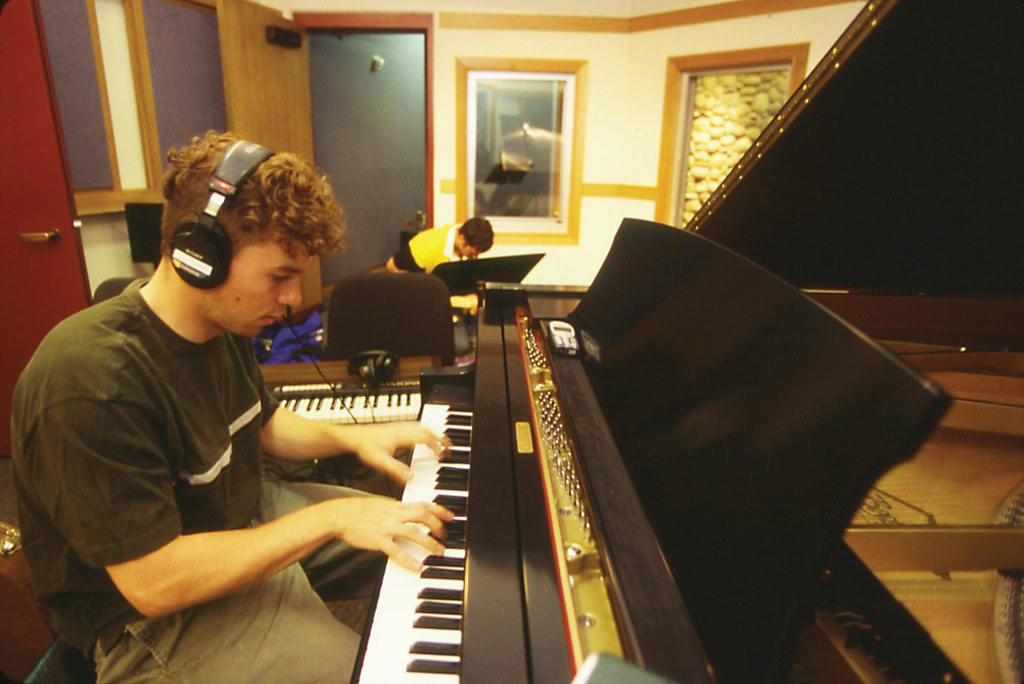Are you interested in learning how to get into music production? Whether you’re an aspiring producer or just want to create your own music, this comprehensive guide will give you all the information you need to get started. We’ll cover everything from the equipment and software you need to setting up your own home recording studio. With our step-by-step instructions and expert tips, you’ll be on your way to creating professional-quality music in no time. So, let’s dive in and begin your music production journey!
Music Production: Definition and Benefits
Music production is the process of creating a recorded music product using various technical and creative skills, including recording, mixing, editing, and mastering. It is a broad field that encompasses many different roles, such as the producer, sound engineer, and composer.
Music production genres and styles vary widely, from rock and pop to electronic and hip-hop. Learning music production has numerous benefits. It allows you to express your creativity, collaborate with other musicians, and turn your musical ideas into reality. Additionally, music production skills are highly sought-after in the music industry, and can lead to a fulfilling career in music. Even if you don’t plan to pursue music production professionally, it’s a great hobby that can bring you joy and satisfaction.
Table of Contents

Music Production Equipment
To get started in music production, you’ll need some essential equipment. The type of equipment you need will depend on what you want to achieve. Here are some of the most important pieces of equipment you’ll need:
Microphones
Microphones are essential for capturing sound in music production. There are many types of microphones available, such as dynamic and condenser microphones. Dynamic microphones are great for recording loud sounds, like drums or guitar amps. Condenser microphones are more sensitive and are ideal for recording vocals and acoustic instruments.
Audio Interface
An audio interface is used to connect your microphone or instrument to your computer. It’s important to choose an audio interface that has good sound quality and low latency. A low latency is essential for real-time monitoring and recording without any noticeable delay.
Studio Monitors
Studio monitors are specialized speakers that are designed to provide accurate and balanced sound. They are essential for mixing and mastering your music. When choosing studio monitors, look for a flat frequency response and a clean and detailed sound.
Digital Audio Workstation (DAW)
A DAW is a software application that allows you to record, edit, and mix your music. There are many DAWs available, such as Ableton Live, Logic Pro X, and FL Studio. When choosing a DAW, consider the features you need, the user interface, and the compatibility with your computer and plugins.
MIDI Controller
A MIDI controller is a device that allows you to control your DAW and virtual instruments with physical knobs, buttons, and keys. It’s a great tool for creating and manipulating sounds in real-time. When choosing a MIDI controller, consider the number of keys, pads, and knobs you need, as well as the compatibility with your DAW.
Headphones
Headphones are essential for monitoring your music while recording and mixing. It’s important to choose headphones that provide accurate and detailed sound. Look for headphones that have a flat frequency response and a comfortable fit. Closed-back headphones are ideal for recording, while open-back headphones are great for mixing.
When choosing equipment, it’s important to keep in mind your budget and the type of music you want to produce. You don’t need to buy the most expensive equipment to make great music. There are many affordable options available that can still provide high-quality results.

Setting up a Home Recording Studio
Setting up a home recording studio is easier than you might think. With the right equipment and software, you can create professional-quality recordings from the comfort of your own home. Here are some steps to help you get started:
1. Choose the Right Room
Choosing the right room is crucial for setting up your home recording studio. Look for a room that is quiet and has good acoustics. Avoid rooms with too much echo or background noise. If possible, choose a square or rectangular room as opposed to an irregularly shaped room, as this can make it easier to control the acoustics.
2. Soundproof Your Studio
Soundproofing your studio is important to prevent sound from leaking in or out. You can use acoustic foam or sound blankets to create a soundproof environment. Place the foam or blankets on the walls, ceiling, and floor to absorb sound waves and reduce echo.
3. Install Your Equipment
Once you have your room set up, it’s time to install your equipment. This includes your audio interface, studio monitors, and MIDI controller. Make sure to place your equipment in a way that is comfortable and ergonomic for you to use. You may also want to invest in a quality microphone and headphones.
4. Organize Your Cables
Cables can be a major source of interference and noise in your recordings. Keep your cables organized and tidy by using cable ties or Velcro straps. This will help prevent interference and ensure that your recordings sound as clean as possible.
5. Acoustic Treatment
Acoustic treatment can help improve the sound quality in your studio. You can use bass traps and acoustic panels to control the sound reflections in your room. Bass traps are designed to absorb low-frequency sound waves, while acoustic panels are designed to absorb mid and high-frequency sound waves. Place the bass traps in the corners of your room and the acoustic panels on the walls and ceiling to help balance the sound in your room.
By following these steps, you can create a comfortable and professional home recording studio that will allow you to create music whenever you want.

Music Production Software
Music production software, also called digital audio workstations (DAWs), are essential tools for producing music. The right software can help you create, record, edit, and mix your music with ease. There are many different DAWs available, each with its unique features and workflow. Here are some of the most popular DAWs:
Ableton Live
Ableton Live is a popular DAW for electronic music production. It has a unique workflow that allows you to create and perform music in real-time. This DAW is perfect for DJs, live performers, and producers who want to create music on the fly. Ableton Live has a range of built-in instruments and effects, making it easy to produce tracks without the need for external plugins.
Logic Pro X
Logic Pro X is a popular DAW for Mac users. It’s a versatile DAW that has a user-friendly interface and powerful features for recording, editing, and mixing. This DAW is perfect for producers who want to create music across multiple genres. Logic Pro X has a range of built-in instruments and effects, including the Alchemy synthesizer, which makes it easy to create unique sounds.
FL Studio
FL Studio, also known as FruityLoops, is a popular DAW for hip-hop and electronic music production. It has a user-friendly interface and includes a wide range of virtual instruments and effects. This DAW is perfect for producers who want to create beats and melodies quickly. FL Studio has a step sequencer for creating drum patterns, and a piano roll for creating melodies.
Pro Tools
Pro Tools is a popular DAW for professional music production. It’s widely used in the music industry and has powerful features for recording, editing, and mixing. Pro Tools is perfect for producers who want to produce high-quality music with a professional sound. This DAW has a range of built-in plugins, including EQs, compressors, and reverbs.
When choosing a DAW, it’s essential to consider your budget, the type of music you want to produce, and your personal workflow. Some DAWs are better suited for certain genres of music, while others are more versatile. It’s also essential to consider whether you want a DAW that includes built-in plugins or if you want to use external plugins.

Music Production Techniques
To create high-quality recordings, music production techniques are essential. Here are some popular techniques used in music production:
Compression
Compression is a technique that reduces the dynamic range of a sound. It is used to make loud sounds quieter and quiet sounds louder, which can help to create a more balanced mix. Compression can be applied to individual tracks or to the entire mix.
Equalization (EQ)
Equalization, or EQ, is a technique used to adjust the frequency balance of a sound. It can be used to remove unwanted frequencies or enhance specific frequencies. EQ can be used to create a more balanced mix, correct issues with individual tracks, or add creative effects.
Reverb
Reverb is a technique used to simulate the acoustic space of a recording environment. It can be used to make sounds sound more natural or to create a sense of depth in a mix. Reverb can be applied to individual tracks or to the entire mix.
Sampling
Sampling is a technique used to take a small part of a sound and use it in a new context. It’s widely used in hip-hop and electronic music production. Sampling can be used to create unique sounds or to add texture to a mix.
Mixing and Mastering
Mixing and mastering are two essential techniques used in music production. Mixing involves balancing the levels of each track in a mix and applying effects like compression, EQ, and reverb. Mastering is the process of preparing a mix for distribution by adjusting the overall sound and volume of the mix. It involves applying effects like compression, EQ, and limiting to create a polished, professional sound.
Recording Techniques
Recording techniques are essential for capturing high-quality recordings. Some popular techniques include using high-quality microphones, controlling the acoustics of the recording environment, and using proper microphone placement. By using these techniques, you can capture the best possible sound when recording.
Automation
Automation is a technique used to adjust the levels of individual tracks or effects over time. It can be used to create dynamic changes in a mix, such as gradually increasing the volume of a chorus. Automation can be applied to individual tracks or to the entire mix.
Layering
Layering is a technique used to create complex sounds by combining multiple layers of sounds. It can be used to create unique textures and add depth to a mix. Layering can be applied to individual tracks or to the entire mix.
By using these techniques, you can take your music production skills to the next level and create high-quality, professional-sounding recordings.

Music Production Tutorials and Courses
If you’re looking to improve your music production skills, taking tutorials and courses can be a great way to learn new techniques and get expert guidance. Here are some popular online resources for learning music production:
Udemy
Udemy is a popular online learning platform that offers a wide range of music production courses for beginners and advanced users. You can choose from courses on specific software, such as Ableton Live or Logic Pro X, or take a more general course on music production fundamentals.
Coursera
Coursera is another online learning platform that offers music production courses from top universities and instructors. Some of the courses are free, while others require a fee to enroll.
YouTube
YouTube is a treasure trove of music production tutorials and videos. You can find tutorials on specific techniques, reviews of music production equipment, and much more.
LinkedIn Learning
LinkedIn Learning (formerly Lynda.com) is a popular online learning platform that offers a wide range of music production courses for beginners and advanced users. You can choose from courses on specific software, such as Pro Tools or FL Studio, or take a more general course on music production techniques.
When choosing a course or tutorial, it’s important to consider your skill level and learning goals. Some courses are designed for complete beginners, while others assume a certain level of knowledge. It’s also important to read reviews and ratings from other students to ensure that the course is high-quality and effective.

Music Promotion and Distribution
Promoting and distributing your music is crucial to building a fan base and connecting with other musicians. Here are some tips for promoting and distributing your music:
Use Social Media
Social media is an excellent way to promote your music and engage with your audience. Platforms like Facebook, Twitter, and Instagram provide a direct line of communication with your fans. Here are some best practices for using social media:
- Keep your social media profiles up-to-date and consistent with your brand.
- Share your music, behind-the-scenes photos, and personal anecdotes to engage with your audience.
- Respond to comments and messages to build a connection with your fans.
Upload to Streaming Services
Uploading your music to streaming services like Spotify, Apple Music, and Tidal is an essential step in getting your music heard. These platforms allow you to reach a wider audience and can help you gain new fans. Here are some tips for uploading your music to streaming services:
- Follow the platform’s guidelines to ensure your music is formatted correctly.
- Optimize your metadata, including your artist name, track titles, and album art, to help your music stand out.
- Promote your music on social media and other channels to drive traffic to your streaming profiles.
Collaborate with Other Musicians
Collaborating with other musicians is an effective way to expand your audience and connect with other artists. Here are some tips for collaborating with other musicians:
- Choose collaborators who complement your style and sound.
- Set clear goals and expectations for the collaboration, including deadlines and distribution plans.
- Use collaboration as an opportunity to learn from other musicians and expand your skills.

Common Music Production Myths Debunked
Music production is surrounded by myths and misconceptions. Unfortunately, these myths can discourage aspiring producers from pursuing their passion. In this section, we will debunk some of the most common music production myths and set the record straight.
Myth: You need expensive equipment to make good music.
Many people believe that you need expensive equipment to produce high-quality music. However, this couldn’t be further from the truth. While high-end equipment can certainly improve the quality of your recordings, it’s not a necessity. Some of the world’s most successful musicians started their careers with budget equipment and have gone on to produce great music. The key is to focus on your skills and creativity rather than the cost of your equipment.
Myth: You need to be a technical expert to produce music.
Another common myth is that you need to be a technical expert to produce music. While technical knowledge can be helpful, music production is primarily about creativity and experimentation. You don’t need to be an expert in music theory or computer programming to create great music. Instead, focus on developing your skills through practice and experimentation.
Myth: Mixing and mastering are the same thing.
Mixing and mastering are two separate processes that serve different purposes. Mixing involves balancing and processing individual tracks to create a cohesive sound. Mastering, on the other hand, involves preparing the final mix for distribution by making global adjustments to the overall sound. While both processes are important, they require different skills and techniques. It’s important to understand the difference between mixing and mastering to achieve a polished and professional final product.

Pros and Cons of Choosing a Digital Audio Workstation
Choosing the right digital audio workstation (DAW) is a crucial decision for any music producer. There are many DAWs available in the market, each with its own set of pros and cons. Here are some pros and cons of some of the most popular DAWs:
Ableton Live
Ableton Live has a unique workflow that sets it apart from other DAWs, making it an excellent choice for live performance and production. It is widely used for electronic music production, but can be used for other genres as well. Some of the pros and cons of Ableton Live are:
Pros
- Unique workflow for live performance and production
- Excellent session view for loop-based music creation
- Great time-stretching and warping capabilities
- Built-in instruments and effects are of high quality
- Wide range of third-party plugins available
Cons
- Limited mixing and mastering capabilities
- Steep learning curve for beginners
- Not as versatile as other DAWs when it comes to recording and editing live instruments
Logic Pro X
Logic Pro X is a popular DAW among Mac users, known for its user-friendly interface and powerful features. It is widely used for audio recording, editing, mixing, and mastering. Some of the pros and cons of Logic Pro X are:
Pros
- User-friendly interface and powerful features
- Excellent stock plugins and virtual instruments
- Great for MIDI editing and scoring
- Smart Controls feature for quick access to plugin parameters
- Wide range of third-party plugins available
Cons
- Only available on Mac
- Limited support for third-party hardware controllers
- Not as flexible as other DAWs when it comes to routing and bussing
FL Studio
FL Studio is known for its user-friendly interface and wide range of instruments and effects. It is widely used for electronic music production, but can be used for other genres as well. Some of the pros and cons of FL Studio are:
Pros
- User-friendly interface and wide range of instruments and effects
- Built-in step sequencer for creating beats and patterns
- Great for loop-based music creation
- Excellent automation capabilities
- Wide range of third-party plugins available
Cons
- Limited MIDI editing capabilities
- Not as versatile as other DAWs when it comes to recording and editing live instruments
- Not as flexible as other DAWs when it comes to routing and bussing
Pro Tools
Pro Tools is an industry-standard DAW for professional music production. It is widely used in recording studios, post-production houses, and broadcast facilities. Some of the pros and cons of Pro Tools are:
Pros
- Industry standard for professional music production
- Excellent audio editing and mixing capabilities
- Great for large-scale projects with multiple tracks
- Wide range of third-party plugins available
- Excellent support for third-party hardware controllers
Cons
- Expensive and complex to use
- Steep learning curve for beginners
- Not as user-friendly as other DAWs
- Limited support for MIDI editing and scoring

Room Acoustics: A Crucial Element of Music Production
When it comes to music production, understanding the importance of room acoustics is crucial. The way sound travels and is absorbed in a room can significantly impact the quality of your final product. To ensure that your home recording studio is set up for optimal acoustics, there are several key factors to consider:
Room size and shape
The size and shape of the room can have a significant impact on the way sound travels. It is important to choose a room that has dimensions conducive to good acoustics. Generally, larger rooms tend to have better acoustics than smaller ones, but the shape of the room can also play a role. Rectangular rooms are preferred over square rooms, as they offer better sound reflections.
Wall and ceiling materials
The materials used for walls and ceilings can also play a role in the way sound is absorbed and reflected. Hard surfaces such as concrete or tile can create too much echo, while soft surfaces like carpet or acoustic foam can absorb too much sound. It is important to strike a balance between these two extremes to achieve optimal acoustics.
Furniture and equipment placement
The placement of furniture and equipment can also impact the way sound travels in a room. It is important to experiment with different positions to find the best sound for your recordings. Try to avoid placing large furniture items in the corners of the room, as this can create unwanted bass buildup.
Acoustic treatment
Adding acoustic panels, bass traps, and diffusion panels can help to control the way sound is absorbed and reflected in the room. This can greatly improve the quality of your recordings. Acoustic treatment is especially important if you are recording in a small space, as it can help to mitigate the negative effects of room acoustics.
By taking these factors into consideration and making the necessary adjustments, you can ensure that your home recording studio is set up for optimal acoustics. This will help you to achieve professional-quality recordings and take your music production skills to the next level.

Insider Tips for Music Production Beginners
Insider tips can be valuable for newcomers to music production. These tips can help you get a head start and improve your skills. Here are some insider tips from experienced music producers:
Practice Regularly
Consistent practice is key to improving your skills in music production. It might be tempting to wait for inspiration to strike, but the most successful music producers make a habit of practicing every day. Even if it’s just for a few minutes each day, make sure to practice and experiment with different techniques. This will help you develop your skills and improve your music production abilities.
Develop a Critical Ear
When listening to music, try to analyze and break down the different elements of the production. This will help you to develop your ear and identify different sounds and effects. You’ll begin to notice how different instruments and sounds fit together and how they contribute to the overall sound of a track. This will help you develop your own unique style and sound.
Collaborate with Other Musicians
Collaboration is a great way to learn from other musicians and expand your creativity. Work with other producers, singers, and instrumentalists to gain new perspectives and ideas. You’ll learn new techniques from other producers and may even discover new sounds and styles that you wouldn’t have found otherwise.
Embrace Mistakes
Making mistakes is a natural part of the learning process. Don’t be afraid to experiment and try new things, even if it doesn’t always work out. Some of the best music productions have come from happy accidents and experimentation. Embrace your mistakes and use them as an opportunity to learn and improve your skills.
Frequently Asked Questions about Music Production
If you’re new to music production, you probably have a lot of questions. Here are some of the most frequently asked questions about music production:
Q: Do I need expensive equipment to make good music?
A: No, you don’t need expensive equipment to make good music. Many successful musicians have started with budget equipment and have gone on to produce great music. While high-end equipment can certainly help improve the quality of your music, it’s not necessary when you’re just starting.
Q: How long does it take to learn music production?
A: Learning music production is an ongoing process, and it can take years to master. However, with consistent practice and dedication, you can make significant progress in a short amount of time. The key is to start with the basics and gradually work your way up to more complex techniques. There are many online courses and tutorials available that can help you learn music production at your own pace.
Conclusion
Congratulations! You’ve just embarked on an exciting journey into the world of music production. By following the tips and techniques outlined in this guide, you are now equipped with the knowledge and skills to create high-quality recordings and take your music to the next level.
Remember that practice makes perfect, and don’t be afraid to experiment with different techniques and sounds. Use reference tracks to guide your mixing and mastering, collaborate with other musicians to learn new skills, and take breaks to avoid ear fatigue.
Finally, never stop learning. The world of music production is constantly evolving, and there’s always something new to discover. Keep exploring and experimenting, and who knows where your music production journey will take you!
If you found this guide helpful, be sure to check out our other content on music production and related topics. Happy producing!

